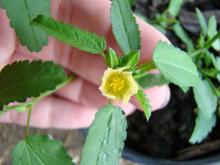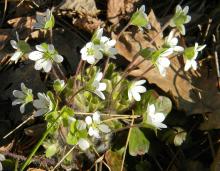Wildflowers, Grasses and Other Nonwoody Plants
Media

Species Types
Scientific Name
Physalis longifolia
Description
Common ground cherry is closely related to the tomatillo, which you’ve probably seen in the grocery store or had in a delicious salsa verde at a Mexican restaurant. The fruits of ground cherry are edible, too.
Media

Species Types
Scientific Name
Datura stramonium
Description
Pretty but poisonous, jimsonweed has white goblet-shaped flowers that open around midnight. This native of tropical America was introduced nearly throughout the United States and thrives in disturbed soils.
Media

Species Types
Scientific Name
Lysimachia lanceolata
Description
You can find small colonies of lance-leaved loosestrife nearly throughout the state. It has showy but nodding yellow flowers and opposite, closely spaced, lanceolate or ovate leaves.
Media

Species Types
Scientific Name
Triosteum perfoliatum
Description
Even without its flowers, or its fruits that resemble miniature oranges, common horse gentian is notable for its opposite leaves, which are broadly fused together at the bases and almost appear as a single leaf with a stem going through it.
Media

Species Types
Scientific Name
Sida spinosa
Description
Prickly sida, a weedy plant seen along roadsides, streambanks, and the edges of fields, is in the same family as hibiscus, okra, and hollyhocks. A small, spinelike projection grows at base of each leaf.
Media

Species Types
Scientific Name
Ipomoea pandurata
Description
Wild potato vine is related to the sweet potatoes we buy at grocery stores. This native vine is also related to the morning glories that decorate trellises and to the bindweed that plagues gardeners and farmers.
Media

Species Types
Scientific Name
Solanum carolinense
Description
Horse nettle is a native perennial with spiny stems and leaves, white to purplish flowers, and toxic fruits that look like tiny yellow tomatoes. It does well in disturbed habitats, and many people consider it a weed.
Media

Species Types
Scientific Name
Anemone americana (syn. Hepatica nobilis var. obtusa)
Description
One of seven species of windflowers, or anemones in Missouri, liverleaf or round-lobed hepatica occurs in the eastern and southern portions of the Ozarks. It's a hairy plant with one flower per stalk; flowers may be white, pink, blue, or lavender.
Media
Species Types
Scientific Name
Anagallis arvensis (Lysamachia arvensis)
Description
The scarlet pimpernel, a native of Europe, is a tender annual with scarlet or brick-red flowers that close around 4 p.m., or whenever clouds shade the sun. When the sun comes out again, they reopen.
Media

Species Types
Scientific Name
Polytaenia nuttallii
Description
Found mainly in the southern half of the state, in prairies and glades, prairie parsley is an upright, stout-stemmed perennial with small yellow flowers in umbrella-shaped clusters. It blooms April through June.
See Also
About Wildflowers, Grasses and Other Nonwoody Plants in Missouri
A very simple way of thinking about the green world is to divide the vascular plants into two groups: woody and nonwoody (or herbaceous). But this is an artificial division; many plant families include some species that are woody and some that are not. The diversity of nonwoody vascular plants is staggering! Think of all the ferns, grasses, sedges, lilies, peas, sunflowers, nightshades, milkweeds, mustards, mints, and mallows — weeds and wildflowers — and many more!





















